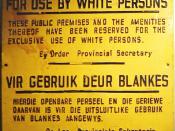Black men in South Africa are most commonly remembered for their efforts in the anti-Apartheid struggles and these black men should not be disregarded. However, a prominent political party who also resisted the Apartheid policies was a group of white women, known as the Black Sash or more commonly as Sash. These women were characterised by their black sashes embedded with the words "Eerbedieg ons Grondwet" (Honour our Constitution) in an attempt to show their mourning for the South African Constitution due to its harsh Apartheid laws.
Many members of Sash felt that the black sashes initially worn for mourning of the Constitution, were later worn in accordance to the mourning of "the death of thousands of children, year after year, from deficiency diseases" as well as mourning for "the broken homes that result from an influx of control regulations." 1
The Black Sash was founded in May 1955 by a tea party of six white women, with their first president being Jean Sinclair (see Appendix 1) who was later awarded an honourary doctorate by the University of Witwatersrand for her work.
Members of the Black Sash "used the relative safety of their privileged racial classification to speak out against the erosion of human rights in the country. But they were not only on the streets. Volunteers spent many hours in the national network of advice offices and in the monitoring of courts and pass offices." 2
Sash's initial objective was to protest against the Senate Bill which would remove Coloured voters from the common voters' role in the Cape province. The first march by the Black Sash was on 25 May 1955 and consisted of 2500 women who peacefully marched to the Johannesburg City Hall to show the mayor their dissatisfaction with the proposed Senate Bill(See Appendix 2). The...


